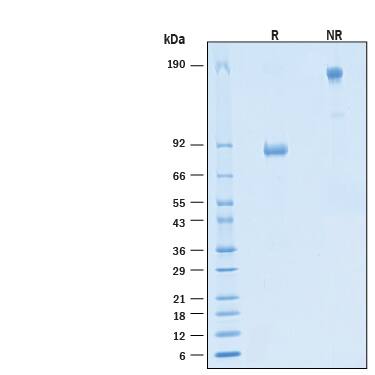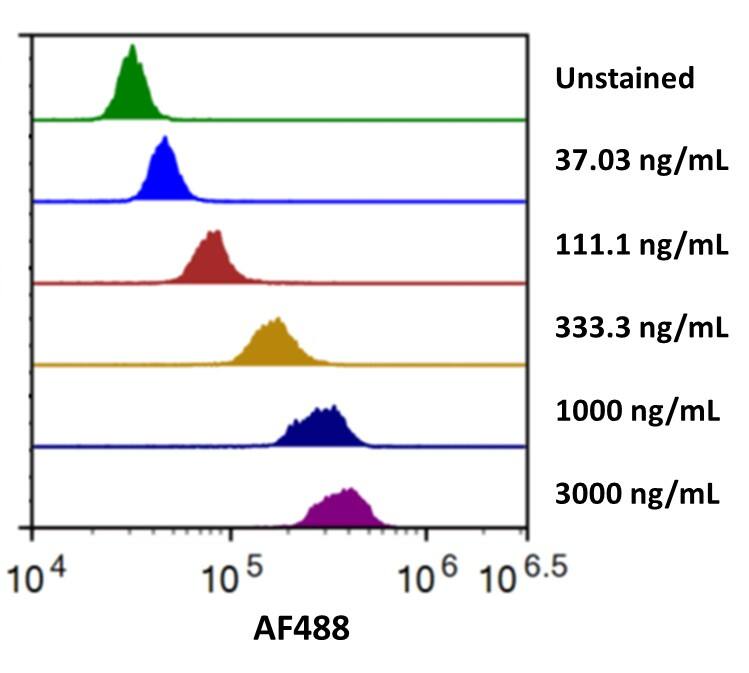Recombinant Human B7-H2 Fc Chimera Alexa Fluor® 488 Protein
R&D Systems, part of Bio-Techne | Catalog # AFG165

Key Product Details
Source
Accession #
Structure / Form
Labeled with Alexa Fluor® 488 via amines
Excitation Wavelength: 488 nm
Emission Wavelength: 515-545 nm
Conjugate
Applications
Product Specifications
Source
| Human B7-H2 (Asp19-Ser258) Accession # O75144.2 |
DIEGRMD | Human IgG1 (Pro100-Lys330) |
| N-terminus | C-terminus |
Purity
Endotoxin Level
N-terminal Sequence Analysis
Predicted Molecular Mass
SDS-PAGE
Activity
Scientific Data Images for Recombinant Human B7-H2 Fc Chimera Alexa Fluor® 488 Protein
Flow cytometry analysis for Recombinant Human B7‑H2 Fc Chimera Alexa Fluor® 488 staining on human B7-H2 antibody conjugated beads.
Streptavidin coated beads conjugated to Human B7-H2 Biotinylated Antibody were stained with the indicated concentrations of Recombinant Human B7‑H2 Fc Chimera Alexa Fluor® 488 (Catalog # AFG165).Recombinant Human B7‑H2 Fc Chimera Alexa Fluor® 488 Protein SDS-PAGE.
2 μg/lane of Recombinant Human B7‑H2 Fc Chimera Alexa Fluor® 488 Protein (Catalog # AFG165) was resolved with SDS-PAGE under reducing (R) and non-reducing (NR) conditions and visualized by Coomassie® Blue staining, showing bands at 80-90 kDa and 160-180 kDa, respectively.Formulation, Preparation and Storage
AFG165
| Formulation | Supplied as a 0.2 μm filtered solution in PBS with BSA as a carrier protein. |
| Shipping | The product is shipped with dry ice or equivalent. Upon receipt, store it immediately at the temperature recommended below. |
| Stability & Storage | Protect from light. Use a manual defrost freezer and avoid repeated freeze-thaw cycles.
|
Background: B7-H2
References
- Bour-Jordan, H. et al. (2011) Immunol. Rev. 241:180.
- Wang, S. et al. (2000) Blood 96:2808.
- Yoshinaga, S.K. et al. (2000) Int. Immunol. 12:1439.
- Yoshinaga, S.K. et al. (1999) Nature 402:827.
- Faget, J. et al. (2012) Cancer Res. 72:6130.
- Yao, S. et al. (2011) Immunity 32:729.
- Watanabe, M. et al. (2008) J. Immunol. 180:5222.
- Wong, S.-C. et al. (2003) Blood 102:1381.
- Hu, Y.-L. et al. (2009) J. Immunol. 182:1421.
- Kadkhoda, K. et al. (2010) J. Immunol. 184:3780.
- Kadkhoda, K. et al. (2011) Int. Immunol. 23:239.
- Gajewska, B.U. et al. (2005) J. Immunol. 174:3000.
- Akbari, O. et al. (2002) Nat. Med. 8:1024.
- Her, M. et al. (2009) Lupus 18:501.
- Wang, F. et al. (2012) J. Clin. Immunol. 32:1253.
Long Name
Alternate Names
Gene Symbol
UniProt
Additional B7-H2 Products
Product Documents for Recombinant Human B7-H2 Fc Chimera Alexa Fluor® 488 Protein
Product Specific Notices for Recombinant Human B7-H2 Fc Chimera Alexa Fluor® 488 Protein
This product is provided under an agreement between Life Technologies Corporation and R&D Systems, Inc, and the manufacture, use, sale or import of this product is subject to one or more US patents and corresponding non-US equivalents, owned by Life Technologies Corporation and its affiliates. The purchase of this product conveys to the buyer the non-transferable right to use the purchased amount of the product and components of the product only in research conducted by the buyer (whether the buyer is an academic or for-profit entity). The sale of this product is expressly conditioned on the buyer not using the product or its components (1) in manufacturing; (2) to provide a service, information, or data to an unaffiliated third party for payment; (3) for therapeutic, diagnostic or prophylactic purposes; (4) to resell, sell, or otherwise transfer this product or its components to any third party, or for any other commercial purpose. Life Technologies Corporation will not assert a claim against the buyer of the infringement of the above patents based on the manufacture, use or sale of a commercial product developed in research by the buyer in which this product or its components was employed, provided that neither this product nor any of its components was used in the manufacture of such product. For information on purchasing a license to this product for purposes other than research, contact Life Technologies Corporation, Cell Analysis Business Unit, Business Development, 29851 Willow Creek Road, Eugene, OR 97402, Tel: (541) 465-8300. Fax: (541) 335-0354.
This product is provided under an agreement between Life Technologies Corporation and R&D Systems, Inc, and the manufacture, use, sale or import of this product is subject to one or more US patents and corresponding non-US equivalents, owned by Life Technologies Corporation and its affiliates. The purchase of this product conveys to the buyer the non-transferable right to use the purchased amount of the product and components of the product only in research conducted by the buyer (whether the buyer is an academic or for-profit entity). The sale of this product is expressly conditioned on the buyer not using the product or its components (1) in manufacturing; (2) to provide a service, information, or data to an unaffiliated third party for payment; (3) for therapeutic, diagnostic or prophylactic purposes; (4) to resell, sell, or otherwise transfer this product or its components to any third party, or for any other commercial purpose. Life Technologies Corporation will not assert a claim against the buyer of the infringement of the above patents based on the manufacture, use or sale of a commercial product developed in research by the buyer in which this product or its components was employed, provided that neither this product nor any of its components was used in the manufacture of such product. For information on purchasing a license to this product for purposes other than research, contact Life Technologies Corporation, Cell Analysis Business Unit, Business Development, 29851 Willow Creek Road, Eugene, OR 97402, Tel: (541) 465-8300. Fax: (541) 335-0354.
For research use only

